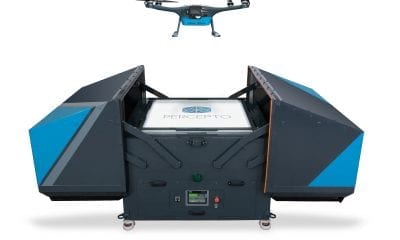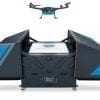Autonomous Drones, Blockchain and Smart Cities: An Interview with DAV’s Noam Copel and John Frazer
DAV – Decentralized Autonomous Vehicles – is an innovative platform created by the Swiss non-profit DAV Foundation, that has the potential to completely disrupt the way simple everyday procedures like delivering packages or even ordering taxis. At first glance it appears to be as simple as a smartphone app – and indeed this is how many of us will experience it. But it is much more than that, bolstered by an impressive board of advisors from names like NASA, SAP, Ethereum, FAA and Equinix. Making use of blockchain and autonomous technologies to create a whole new transport protocol, DAV could change the very way we do things, as we find out in a joint interview with CEO Noam Copel and CCO John Frazer.
Hi Noam and John, thanks for joining us. You’ve assembled a top team; names from NASA, Ethereum, SAP, Equinox and Bancor. What was the catalyst for bringing this team together?
Noam: The vision we have for DAV is colossal in scope; therefore we knew we needed advisors and team members who were among the very best at what they did. DAV is profoundly transformational, and will potentially create not only a new world of transportation, but also carries powerful social benefits. We believe these factors helped us draw together the stellar team we have today.
DAV has been likened to the UBER of delivery. Could you walk our readers through exactly how they would use the DAV network to order their Friday night pizza? Say their grandma was over for dinner, how would they explain it to her?
Noam: For the sake of clarity: DAV is actually a common, open transportation network. An “UBER-like” delivery system is just one of many use cases that could be executed on DAV.
Let’s assume that the pizza place doesn’t do deliveries. You order the pizza and you’re notified that it will be ready in 30 minutes. You’d like the pizza delivered quickly, so you log onto a drone app that searches nearby for drones on the DAV network that are available for use. Each drone may have special characteristics: one might be very fast and is used for urgent deliveries, another is a freight drone that can lift 600 lbs., and so forth. You enter the parameters for your “mission” – I need a drone to go to point A to get my payload, and bring it to me at point B. The drones bid on that mission, and you choose the one that makes the most economic sense to you. A very fast drone might cost more than one that moves at a more sedate pace, for example.
The drone goes to pick up your pizza at the appointed time, and heads to your home. Now this drone is autonomous, and its smart enough to realize it doesn’t have enough battery power left to complete the mission. The drone searches on the DAV network for charging stations, and selects from the stations that bid on the charging. The drone lands, charges up quickly, moves cryptocurrency from its own cryptowallet in the form of DAV tokens in payment to the charging station’s cryptowallet, and carries on to complete it mission. You get your pizza and the drone notifies the DAV network that it is available for the next mission.
Explaining this to grandma could be as simple as saying, “We can move anything or anyone anywhere from our smartphones.” That means being able to use a ride-hailing service, or drone deliveries, or rover services, among other scenarios.
An important thing here to note is that for the vast majority of the users, they won’t even have to think about how DAV works. It just does. It’s very similar to the World Wide Web. The average consumer doesn’t think about TCP/IP which is the underlying technology stack that makes the Web work. They just open their browser and click.
It sounds deceptively simple; what are the combinations of technology that drive this new system?
John: The DAV network is built on the Ethereum blockchain, so we utilize a lot of Ethereum’s baked-in features. Ethereum of course rides on top of the Internet. Then there are the communication and sensor technologies used by autonomous vehicle manufacturers, but we don’t have a hand in that.
Your first iteration of the technology is the Drone Missions app. How is this app involved in connecting the vehicles and infrastructure needed to bring it all together?
John: Apps like the Missions app are really just communication interfaces for users. The actual connections are made over the DAV network, and information is reported to the instances of the apps that request data.
How does DAV differ from other disruptive marketplaces like Uber and Lyft?
Noam: DAV is a network and a protocol. A good way of thinking about it is that DAV is a road system while Uber and Lyft are services that bring together drivers and riders. Uber or Lyft could conceivably use DAV as a way of reaching other markets. DAV’s primary disruptive effect is in providing opportunities in a brand-new transport commons to entrepreneurs and existing enterprises in the transportation sector. Consider what the World Wide Web did for businesses on the Internet. Silos like Compuserve and AOL became irrelevant, and billions of experiences are now available to the average consumer online. DAV is comparable, but specifically for the decentralized and autonomous transport vertical.
To what level will the system and the drones servicing it be autonomous? Are we talking true AI, machine learning? What will the level of pilot involvement be?
Noam: Machine autonomy for road vehicles will go through a number of stages over the next decade. We already have cars that can drive themselves, albeit in limited numbers. Over time cars will require less and less monitoring from human drivers, until no human intervention will be required. In the US the National Highway Traffic Safety Administration defined five levels of car autonomy. Once we get to levels 4 and 5 there won’t be a lot of human drivers.
Drones and rovers are much closer to full autonomy as the regulatory space isn’t quite as thorny. Drones do have to contend with aviation regulations and each jurisdiction has its own approach.
Having said all that, even with full machine autonomy (when a machine’s performance can equal or exceed that of a human pilot/driver), I think there will always be a segment of the market that will insist on human intervention.
Can you explain the role of blockchain in the system, and ‘trustless cooperation’? With all the talk of cryptocurrency, privacy and security, what impact is this expected to have on consumer takeup?
John: Blockchain technology enables decentralization. What that means is that we as consumers and service providers don’t need a central agency or organization that has earned our trust to enter into transactions with one another. If we were to send you money for example, our bank would have to talk to your bank, both of which we trust. Blockchain does away with this requirement, because the ledger of transactions is made public and we all have a copy. If you tried to change an entry on your copy of the ledger, everyone else’s ledger would disagree with yours and your change wouldn’t be permitted.
What this does for DAV is it allows us to deploy a network that is both secure and transparent. Just like the Web, no one controls the DAV network, and you don’t need our permission to use it, run a business on it, or consume services on it. Also like the Web, I think we’ll see rapid mainstream adoption upon reaching a critical mass of early adopters and service providers who already grasp the vast opportunities a common network like this can offer.
What steps have been taken so far to make this vision a commercial reality?
Noam: We have a growing coalition of stakeholders in the transport space in our DAV Alliance. We’re working closely with our Alliance members on integrating their products and services with our network, and continue to bring new members on board. We’re also in discussions with a number of top-tier industry organizations around the globe. On top of that we’re taking steps to make it much easier for consumer adoption not too far down the road. Bring that all together under the auspices of network that is open to all and is a greenfield for innovation and entrepreneurship, and we think we have a potent recipe for success.

The DAV Foundation board includes an impressive array of heads from big names in aerospace, automotive, cryptocurrency, data and software
The first focus of DAV Foundation is on deliveries but it seems the net will cast much wider than that. What are the possibilities?
John: Without a hint of hyperbole we would propose that the possibilities are endless. Deliveries, ride-hailing, search and recovery, visual reporting, data collection…these are merely the first order opportunities that are obvious because they leverage functions that are right in front of us. But for every primary business you need secondary businesses that support them, such as with insurance, arbitration, route mapping, and so forth. It’s difficult to predict what the third- and fourth-order opportunities might be, but they’ll come, just as they have for every other industry, within every new framework that has arisen due to technological change.
There’s been mention of search and rescue robots. With DJI and EENA recently celebrating a collaboration to develop search and rescue guidelines, will DAV join the fray in that regard?
John: DAV can provide the network for decentralized SAR services, no question. We’re more than happy to support and help enable organizations who are seeking new ways to leverage their technologies and products.
What do you see is the ultimate future for autonomous peer-to-peer technology?
Noam: That’s very hard to predict, but I think it would be very cool if we all shared transport assets and the challenge of moving people and things became a problem of the past. Just pick up your smartphone, ask to go somewhere, and the solution arrives at your door in minutes.
With DAV’s first token sale now wrapped up and DAV to be listed next week on HitBTC, what will this mean for early adopters of the DAV token?
John: It’s important to us that the DAV token achieves significant liquidity. Showing up on exchanges like HitBTC is more-or-less expected, and thus far we’ve received notice that DAV will also be listed on KuCoin, IDEX,Bitforex, and others. We don’t control listings on exchanges of course. Listings are a matter for the exchanges themselves.
What could the benefits be for the creation and development of smart cities serviced by multiple connected transport options?
John: The benefits are manifold. Two obvious ones that come to mind right away are reduced congestion and a “flattening” of real estate prices. With widely available access to mobility, particularly autonomous mobility, it isn’t nearly as burdensome to live some distance away from your place of work. Urban cores will become more spread out as people have the option to live further away because transport is so convenient and economical.
What are DAV next steps, past delivery networks?
Noam: Now that our token sale is over we’re turning all of our attention towards developing the network and products for primary use cases. Drone deliveries and decentralized ride-hailing are among the first to be addressed. It’s going to be a very exciting few years as we move along our roadmap.
 About Noam Copel, CEO of the DAV Foundation
About Noam Copel, CEO of the DAV Foundation
A senior executive, strategist, and investor, with a strong expertise in blockchain, cryptocurrencies and encryption. In 2003 created the world’s first smartphone encryption system distributed in over 50 countries. Noam is an aviation enthusiast and a multi engine rated pilot.
 About John Frazer, CCO of the DAV Foundation
About John Frazer, CCO of the DAV Foundation
John is the former External Relations lead for the Ethereum Foundation and was a senior member of the Devcon3 team. An experienced senior manager in the technology industry, particularly in strategic communications and marketing roles. He has served on multiple boards for non-profits, for-profits and in economic development. He has a passion for the study of human behaviour and is a graduate of the MBA program from Royal Roads University in Victoria, Canada.
























